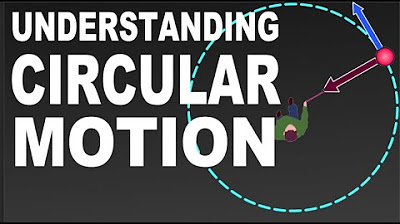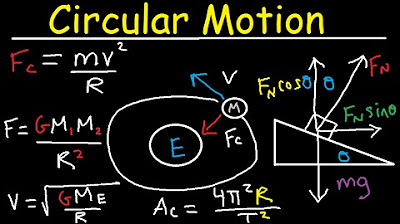What is Centripetal force?
TLDRThe video script explores the concept of centripetal force, which is essential for circular motion. It explains that centripetal force, acting perpendicular to an object's velocity, is responsible for keeping objects like the moon in orbit around the Earth. The script uses a thought experiment with a tennis ball to illustrate how repeated perpendicular forces result in circular motion. It also clarifies that 'centrifugal force' is a pseudo force, only relevant in non-inertial frames of reference like a rotating cabin. The script emphasizes analyzing physical phenomena using centripetal force for accurate scientific and engineering insights.
Takeaways
- 🌌 Centripetal force is the inward force required for an object to move in a circular path, perpendicular to its velocity.
- 🏐 An interesting thought experiment with a tennis ball illustrates how repeated perpendicular forces result in circular motion.
- 🔍 The stronger the centripetal force, the more pronounced the deflection of an object, and the smaller the radius of its circular path.
- 📚 Sir Isaac Newton's definition of force is a starting point for understanding centripetal force analytically.
- 🌕 The gravitational force between the Earth and the Moon provides the necessary centripetal force for the Moon's orbit.
- 🎣 When an object is attached to a string and rotated, the tension in the string supplies the centripetal force.
- 🪵 Frictional force between a spinning wooden block and the floor can also provide the necessary centripetal force.
- 🌀 Centripetal force must come from an external source like gravity, tension, or friction for circular motion to occur.
- 🌀 Centrifugal force is not a real force but a pseudo force experienced in a rotating frame of reference.
- 👀 Observers in a rotating frame, like inside a spinning cabin, may need to consider centrifugal force for analysis.
- 🚫 It's recommended to avoid using centrifugal force in scientific and engineering analyses and focus on centripetal force instead.
Q & A
What is centripetal force?
-Centripetal force is the inward, perpendicular force acting on an object that is moving in a circular path. It is necessary for maintaining the circular motion.
Why is the centripetal force always perpendicular to the velocity of an object in circular motion?
-Centripetal force is perpendicular to the velocity because it is the force that continually changes the direction of the object's velocity without affecting its speed, keeping it in circular motion.
Can you explain the thought experiment with the tennis ball that illustrates how centripetal force creates circular motion?
-The thought experiment involves applying a force perpendicular to the direction of the tennis ball's motion at regular intervals. Over time, with smaller intervals, the path of the ball becomes increasingly circular, demonstrating that a continuous perpendicular force results in circular motion.
What is the relationship between centripetal force and the radius of the circular path?
-The smaller the radius of the circular path, the greater the centripetal force required to maintain the motion. This is because the force needed to change the direction of the velocity increases as the path becomes smaller.
What provides the centripetal force when the moon revolves around the Earth?
-The gravitational force acting between the moon and the Earth provides the necessary centripetal force for the moon's circular orbit around the Earth.
How does the tension in a string attached to a rotating object contribute to centripetal force?
-The tension in the string provides the required centripetal force for the object to maintain its circular motion. Specifically, it is the horizontal component of the tension that acts as the centripetal force.
What is the role of frictional force in providing centripetal force for a spinning wooden block?
-The frictional force between the spinning wooden block and the floor provides the necessary centripetal force that keeps the block moving in a circular path.
What is centrifugal force, and why is it considered a pseudo force?
-Centrifugal force is considered a pseudo force because it does not actually act on a rotating object; rather, it is a perceived force in a rotating frame of reference. It is used to analyze motion from the perspective of an observer who is also rotating.
Why should centrifugal force be avoided in scientific or engineering analyses?
-Centrifugal force should be avoided in scientific or engineering analyses because it is a pseudo force used only in non-inertial (rotating) frames of reference. Working with centripetal force, which is a real force, provides more accurate and universally applicable analysis.
How does the pressure difference in a rotating fluid create the centripetal force needed for circular motion?
-The pressure difference caused by the height disparity of the water level generates the centripetal force needed for the fluid particles to maintain their circular motion. As the rotation speed increases, a greater pressure difference is required, causing the fluid surface to curve more.
What happens to the tension in the rope and the angle of the rope as the ball rotates faster?
-As the ball rotates faster, the tension in the rope must increase to provide the necessary centripetal force. Since the weight of the ball remains constant, the angle of the rope increases to maintain the vertical component of the tension equal to the weight of the ball, causing the ball to move outward.
Outlines
🌌 Understanding Centripetal Force
This paragraph introduces the concept of centripetal force, which is the force that keeps an object moving in a circular path. It explains that this force is always directed towards the center of the circle and is perpendicular to the object's velocity. The script uses the example of the moon revolving around the Earth to illustrate how gravitational force acts as centripetal force. It also describes a thought experiment involving a tennis ball to demonstrate how applying a force perpendicular to the object's motion can result in circular motion. The paragraph emphasizes that centripetal force must be supplied by an external source such as gravity, tension, or friction and explains the relationship between centripetal force, the radius of the circle, and the object's velocity.
🌀 The Misconception of Centrifugal Force
The second paragraph delves into the concept of centrifugal force, which is often misunderstood as a real force acting outward on a rotating object. The script clarifies that centrifugal force is actually a pseudo force, experienced only when analyzing a rotating system from a non-inertial frame of reference. It uses examples such as spinning fluid in a beaker and centrifugal casting to illustrate the apparent outward movement of objects as they rotate faster. The paragraph explains that what appears to be centrifugal force is actually the lack of sufficient centripetal force to maintain circular motion, leading to objects moving outward. It advises against using centrifugal force in scientific and engineering analyses, recommending instead to focus on the real centripetal force required for rotation.
Mindmap
Keywords
💡Centripetal Force
💡Velocity
💡Circular Motion
💡Tension
💡Friction
💡Inertia
💡Centrifugal Force
💡Non-Inertial Frame of Reference
💡Gravitational Force
💡Pseudo Force
Highlights
Centripetal force is required for an object to move in a circular motion and is perpendicular to the velocity.
In circular motion, the force is not in the direction of the velocity, unlike typical mechanics examples.
A thought experiment with a tennis ball illustrates how applying a force perpendicular to motion can result in circular motion.
The shorter the time interval of force application, the closer the path resembles a perfect circle.
Centripetal force is named for its role in directing an object towards the center of its circular path.
An increase in centripetal force results in a smaller circle radius, indicating more deflection.
Centripetal force must be supplied by an external source such as gravity, tension, or friction.
The moon's revolution around the Earth is an example of centripetal force provided by gravitational attraction.
When spinning an object on a string, the tension in the string provides the necessary centripetal force.
Friction between a spinning block and the floor can also provide the centripetal force needed for circular motion.
Centrifugal force is a concept often misunderstood; it is not a real force but a pseudo force.
Centrifugal force is used in physics to analyze problems from a rotating frame of reference.
In a non-rotating frame of reference, such as an observer on the ground, centrifugal force is not needed.
The outward movement of a rotating fluid is due to the need for increased centripetal force as speed increases.
The pressure difference caused by the height disparity of a rotating fluid generates the centripetal force.
As the speed of rotation increases, the water surface curves more due to the need for greater centripetal force.
It is recommended to avoid using centrifugal force in scientific and engineering analyses and to use centripetal force instead.
Transcripts
Browse More Related Video

Centripetal force and acceleration intuition | Physics | Khan Academy

Uniform Circular Motion Free Body Diagrams

Physics - What Is a Centripetal Force?

Understanding Circular Motion

Uniform Circular Motion and Centripetal Force

Centripetal Acceleration & Force - Circular Motion, Banked Curves, Static Friction, Physics Problems
5.0 / 5 (0 votes)
Thanks for rating: